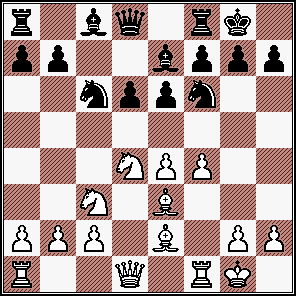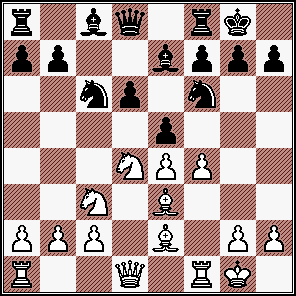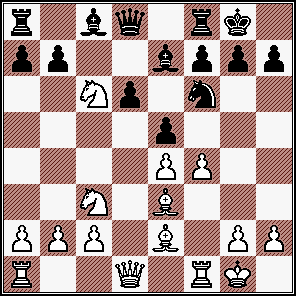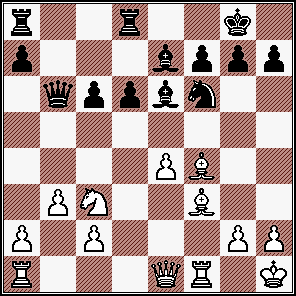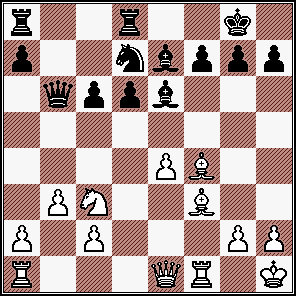All
the |
(Navigation bar
directly below.)
*******
© A.J. Goldsby,
2009.
(All rights reserved.)
****************
Click HERE
to see the page
for my downloads.
****************
Click HERE
to see any chess
items that I have
that are ...
FOR SALE!
****************
****************
Buy a book
from Amazon.com
(And help me out as well!)
Kamsky - Svidler,
|
GM
Gata Kamsky (2671) -
GM Peter Svidler
(2743)
|
|
|
[A.J. Goldsby I]
When I saw this relatively short encounter, I simply knew that I had to add it to my collection.
Any time a 2700+ player loses in such a fashion, we can be sure to learn something if we study it very carefully. (And we may even be entertained in the process!)
** ** ** ** ** ** ** ** ** ** ** ** ** ** ** ** ** ** ** ** ** ** ** ** ** ** ** **
{The ratings are those of FIDE.}
1.e4 c5; (An a-symmetrical
defense.)
Svidler is no rookie in the Sicilian, I found close to 200 examples of his use of this opening in my database. (!)
In 2004, he defeated GM A. Naiditsch in a game in a tournament in Germany.
Another example of his winning a key game
in the Sicilian would have to
be:
GM Michael Adams (2680) - GM Peter Svidler
(2660);
The FIDE World Championship Tournament
{A "knock-out" event.}
/ Round # 4.3 / Groningen, NED /
Dec. 19, 1997.
(I relayed this contest for one chess server, Black won a long game ...
close to 90 overall moves.)
2.Nf3 e6;
(19th century)
This is perfectly respectable, the main alternative here is to play 2...d7-d6; here for Black.
3.d4 cxd4;
4.Nxd4 Nc6;
Black allows a possible Nb5 here by White, apparently Svidler is prepared for that.
Kamsky simply chooses to develop (a fresh piece); rather than to explore the convoluted mysteries of 5.Nb5!?
5.Nc3 d6; (Refinements of the move order?.)
The modern way of playing the Sicilian.
(If Black had chosen a more conventional move order, and had developed his KN first -
instead of his QN - White would have the option of playing the Keres Attack here
with 6.g2-g4!?)
[ Black could have also played: 5...a6; 6.Be2 Qc7; ('!?')
(This is the way Paulsen liked to play the Sicilian.
It was considered bad by the players of his era, but it turns out
that he was over 100 years ahead of his time!)7.0-0 Nf6; 8.Be3 Bb4; {unclear?} with interesting play.
There are hundreds of games, (that results from a search with
this position); in the database, but one of the most entertaining
would have to be:
GM G. Kasparov - GM J. Polgar; / Linares, ESP; 1997.
(1-0, 41 moves.)For a detailed analysis of this encounter, please see Informant # 69.
(Game # 173.) ]
Kamsky - again - simply continues to develop his pieces.
6.Be2 Nf6;
7.0-0 Be7;
We now have transposed to a rather standard line of the Scheveningen Sicilian - one might expect a quick draw. (Except that - at this tournament - draws by agreement have been outlawed!!!)
8.Be3 0-0;
(King-safety)
One book ... that was published in the mid-1970's ... states that: "The move of ...P-QR3
(...a7-a6) is mandatory for Black." The author goes on to explain, in some lengthy detail,
that Black must play this sometime before move ten or eleven. (He also tells us why Black must play this way.)
In the modern lines (of the Scheveningen Sicilian), Black often feels free to skip this move altogether, in favor of various dynamic plans and modes of development.
9.f4,
(center, threat of e4-e5) {See the diagram given - just
below.}
This is probably the most energetic move, although virtually any decent plan would be playable for White ... in this position.
|
|
r1bq1rk1/pp2bppp/2nppn2/8/3NPP2/2N1B3/PPP1B1PP/R2Q1RK1 b
Besides 9.f4 here, White can also try: 9.Kh1, 9.Nb3, 9.Qd2, or even 9.a4.
9...e5!?; {See the diagram given - just
below.}
This looks rather risky, yet the database shows that hundreds of games have been played in
this line.
[ See also Chapter # 11: "The Modern
Scheveningen, 9...e5!?" Page # 75
of the book, <Sicilian: ...e6 and ...d6
Systems.>, By Garry Kasparov and
Aleksander Nikitin. (Published in the U.S. in 1983 by American Chess Promotions.
ISBN: # 0-7134-4022-8 (limp) ]
(Of course, this is an older book, but its one of the few references that I have on this opening.)
|
|
r1bq1rk1/pp2bppp/2np1n2/4p3/3NPP2/2N1B3/PPP1B1PP/R2Q1RK1 w
With this advance, Black weakens the d5-square, but hopes to gain active counterplay for his pieces.
[ It was not too late to transpose (back) into the main line with:
(>/=) 9...a6; ('!') 10.a4 Qc7; 11.Kh1 Re8; 12.Bf3, "~"
when most books claim a small plus ("+/=") for White.GM V. Anand - GM G. Kasparov; / PCA World Championship Match
(G #9) / New York, USA; 1995. {White won in 35 crisp moves.}[ See MCO-14, page # 289; column # 01 and all appropriate,
corresponding notes. ] ]
10.Nxc6!?,
(Maybe - '!') {See the diagram given -
just below.}
Hmmm, interesting. (Kasparov - in the aforementioned book on this opening -
as well as several other authors, give 10.Nb3 as the main line here.)
|
|
r1bq1rk1/pp2bppp/2Np1n2/4p3/4PP2/2N1B3/PPP1B1PP/R2Q1RK1 b
Kamsky plays a different try, one of its aims is not to lose any time. (A master once told me that you should NEVER play "Knight/d4 captures the Knight/c6" in the Sicilian, as it strengthens the second player's center.) Here, the American GM obviously has a new (or different) idea in mind.
[ White could have (also) tried: 10.Nb3 exf4!?; 11.Bxf4 Be6; 12.Kh1 d5!;
13.e5 Nd7; 14.Nxd5 Ndxe5; 15.c4, "+/=" when White has a small edge.GM S. Dolmatov - GM L. Psakhis; / GMA Qualifier (finals, Round. # 1)
Moscow, Russia; 1990. (1-0, 63 m.)
{White won a long and difficult game in sixty-three total moves.}(See also Kuzmin-Kasparov, 1981; or Tal-Kavalek, 1982.
In both of these contests, Black looked OK out of the opening.)(Probably Svidler had prepared for this line. The only Kamsky game
in the database - in this line - that I could find was:
15.c4 Bg5; 16.Bg3 Bh4; 17.Bf4 Bg5; 18.Bg3 Bh4; 19.Bf4, ("=")
with a draw by repetition.GM G. Kamsky - GM V. Anand; / Sicilian Theme Tournament,
/Buenos Aires, ARG; 1994. )*****************************************************************************************
White can also play:
("=") 10.fxe5 dxe5; 11.Nf5 Bxf5; 12.Rxf5 g6!?; (dubious?)
This looks to be like a big weakening of Black's King-side, I prefer
Fritz's move of 11...Qa5.13.Rf2 Nd4; 14.Bd3 b5; The end of the column.
15.a3 a5; 16.Bg5 b4!?;
E. Burnazovic - V. Petrovic; / Team Tournament / Pula, 1990.
{Black won in just under 35 moves}Now White should play: 17.axb4 axb4; 18.Rxa8 Qxa8; 19.Bxf6,
with some advantage. ("+/=") - W. Korn and GM N. de Firmian[ See MCO-14, page # 292; column # 08, and all notes.
Especially see note # (e.) for this particular column. ] ]
10...bxc6;
("Box" or forced.)
Obviously - Black has to take.
11.Kh1,
(Maybe - '!')
This is not a new move, and has been played many times before. (Over
30 games.)
(The idea, I believe, is to safeguard the King and avoid any annoying checks on the a7-g1 diagonal.)
The Kasparov book recommends that White exchange on e5 here, but that appears to lead nowhere for White.
[ Also possible was: 11.f5!?, although after 11...d5!; the second player's
position looks to be preferable at the moment.************************************************************************************
After the following moves:
(</=) 11.fxe5 dxe5; 12.Qe1 Be6; 13.Qg3, "~" (Maybe equal?) {D?}
the first party appears to have little or no advantage in this position. ]
11...exf4;
hmmm
I guess this is playable, (and possibly even good); but it is hardly Black's only move.
(11...Rb8; 11...Qc7; and even 11...a5!?; look to be playable here for Black.)
12.Bxf4,
I feel relatively certain that this is best for White, taking with the Rook looks to be too artificial.
12...Be6;
Black thinks about pushing his QP in this position ...
13.Bf3,
... so White does his best to try and discourage Black from doing this.
(The box likes: 13.Qe1!? - Fritz 9.0)
Now Black activates his Queen, and hits the b-pawn as well. (So White answers this threat with the simplest possible solution.)
13...Qb6; 14.b3 Rfd8N;
Apparently ... this is the first new move of this game, previously the move 15...Rad8 was played.
[ The only other game in the db - that had all the same moves (up to this
particular point) - would be:
14...Rad8; 15.Qe1 Kh8; 16.Rd1, "+/=" with a solid edge for White.
(White won, 1-0, in 55 moves.)Xu Yuhua (2502) - E. Kovalevskaya (2458); / The Women's World Champ.
/ Ekaterinburg, RUS; 2006. ]
15.Qe1,
(clearance, transfer) {See
the diagram given - just below.}
The White Queen moves off the d-file, now the QR can make better use of that line. Additionally, the WQ can come to g3, which is a promising post for the lady. (E.g., K-side attack.) The idea of Qe1-g3 is hardly new in this opening variation, it has been used literally hundreds of times before.
|
|
r2r2k1/p3bppp/1qppbn2/8/4PB2/1PN2B2/P1P3PP/R3QR1K b
This is the crucial position, now it is Black's turn to play here.
(What move would YOU play as Black in this position?)
[ Or 15.Na4 Qa5; 16.c4, "~" ("=") ]
15...Nd7?;
(Maybe even - '??') {See the diagram given - just
below.}
At this level, this is a huge mistake.
(Almost any move was better, Svidler must have missed Kamsky's reply. Normally, in the Sicilian, if you can get your Knight to e5, Black would be OK out of the opening. But here, the idea has a tactical refutation.)
15...Rac8 might have given Black a relatively playable game. (Although I did a detailed analysis, White can pile up on the d-pawn with an edge. Moves like Qg3, followed by doubling the White Rooks on the d-file, etc.)
|
|
r2r2k1/p2nbppp/1qppb3/8/4PB2/1PN2B2/P1P3PP/R3QR1K w
Now take a look at this position. (What move would you play here, if you were playing the White pieces?)
[ >/= 15...Qc5; 16.Rd1, "+/=" ]
16.Nd5!,
(Thematic Knight-leap.)
This must have been the play that the Russian Champion had missed.
[ Or (</=) 16.Na4 Qa6; 17.Rd1, "~" ]
The next two ply are forced.
16...cxd5;
17.exd5 Bg4!?;
This does not seem to help, and it may make matters worse.
(I was inclined to play 17...Bf5 here, and this is the second choice of Fritz.)
[ </= 17...Nc5?!; 18.dxe6 Nxe6; 19.Bxa8 Rxa8; 20.c4, "+/=" ]
18.Qxe7,
(Maybe - '!')
This is easily the best, although White had another path ... that was also good for him. (With this move, White prevents his opponent from getting his Knight to e5, and also exerts the maximum possible pressure ... in many lines, the threat of White playing QxP/d6 considerably
reduces Black's options.)
[ Also - 18.Bxg4, '±' (Maybe "+/-") and White is probably winning here. ]
18...Bxf3!?;
19.Rxf3 Nf6;
This looks like a solid move ... but turns out badly.
(Watch how Kamsky treats this position now.)
[ A little better was: >/= 19...Qa6; (but White is still winning). ]
20.Be3 Qa5;
21.Rxf6!!,
With this move, Kamsky restores the material balance ...
and also fatally exposes Svidler's King.
[ Also good was: 21.Bd4!, '±' ]
21...gxf6;
22.Qxf6 Re8;
23.Qg5+, (Almost - '!')
The correct way to continue this position - for White.
[ But of course not: </= 23.Bh6??, as now 23...Re1+; wins ("-/+") for Black. ]
Now 23...Kh8?; 24.Bd4+, leads to an endgame where White has too many extra pawns.
23...Kf8[];
24.Bd2, "+/-"
................
---> and GM P. Svidler Resigns.
***************************************************************************************************
[ Its a fairly simple win after:
24.Bd2 Qd8;
('[]' ?) The box shows this as Black's only real move at this point.
(Or </= 24...Qc7?!; 25.Qf6 Re5;
26.Rf1! Rxd5; 27.Bh6+ Ke8;
28.Qh8+ Ke7; 29.Qxa8, "+/-" with an extra piece for White.)
25.Qh6+ Kg8; 26.Bc3 f6;
27.Bxf6 Qd7; 28.Qg5+ Kf8;
29.Rf1, "+/-"
with no major problems for the first player on the road to victory.
]
A great game by Kamsky, but obviously a bitterly disappointing result for Peter Svidler.
(Kamsky nearly won the tournament, in the end, he captured clear second place in this powerful event.)
Copyright (c) A.J. Goldsby, 2006. All rights reserved.
1 - 0
The analysis for this page was prepared with the excellent programs, ChessBase 8.0 and ChessBase 9.0.
The HTML was polished with several different tools and programs, (mostly FP) ... the text was checked for spelling with MS Word.
The diagrams were created with the program, Chess Captor 2.25.
Click HERE to - go to or return - to my HOME PAGE ... for this site.
Click HERE to go (or return) to my site map (page).
Click HERE to go to my "Annotated Games II" (page).
Click HERE
to go (or return) to my {2nd}
main page on miniatures / or "Best Short Games," (Vol.
IV.)
(Or you could use the "Back
Button" on your web browser.)
Copyright (c) LM A.J. Goldsby I
Copyright (©) A.J. Goldsby, 2009. All rights reserved.
*******
This page was created in May, 2006. It was posted: 05/27/2006. It was last updated on: June 28, 2009 04:10 AM .
